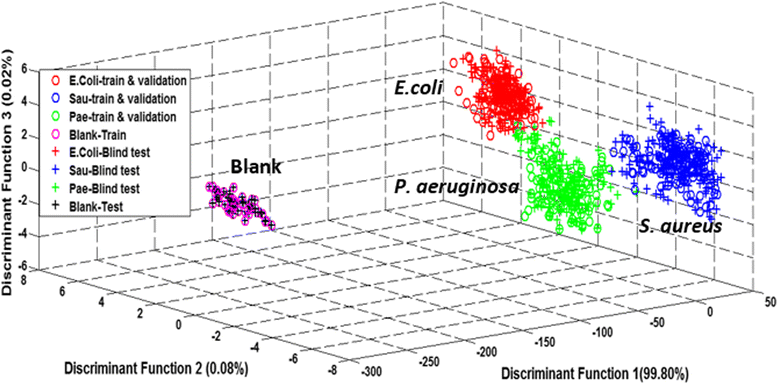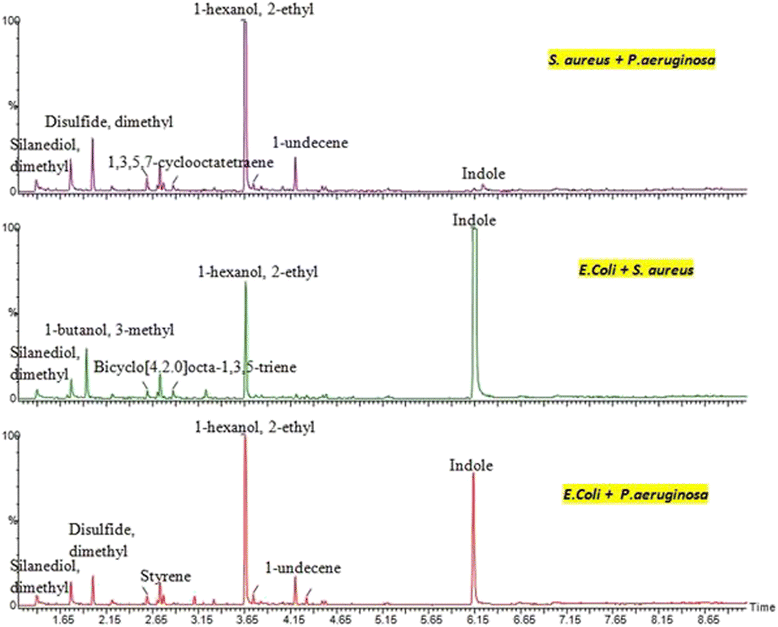In-vitro diagnosis of single and poly microbial species targeted for diabetic foot infection using e-nose technology
- PMID: 25971258
- PMCID: PMC4430918
- DOI: 10.1186/s12859-015-0601-5
In-vitro diagnosis of single and poly microbial species targeted for diabetic foot infection using e-nose technology
Abstract
Background: Effective management of patients with diabetic foot infection is a crucial concern. A delay in prescribing appropriate antimicrobial agent can lead to amputation or life threatening complications. Thus, this electronic nose (e-nose) technique will provide a diagnostic tool that will allow for rapid and accurate identification of a pathogen.
Results: This study investigates the performance of e-nose technique performing direct measurement of static headspace with algorithm and data interpretations which was validated by Headspace SPME-GC-MS, to determine the causative bacteria responsible for diabetic foot infection. The study was proposed to complement the wound swabbing method for bacterial culture and to serve as a rapid screening tool for bacteria species identification. The investigation focused on both single and poly microbial subjected to different agar media cultures. A multi-class technique was applied including statistical approaches such as Support Vector Machine (SVM), K Nearest Neighbor (KNN), Linear Discriminant Analysis (LDA) as well as neural networks called Probability Neural Network (PNN). Most of classifiers successfully identified poly and single microbial species with up to 90% accuracy.
Conclusions: The results obtained from this study showed that the e-nose was able to identify and differentiate between poly and single microbial species comparable to the conventional clinical technique. It also indicates that even though poly and single bacterial species in different agar solution emit different headspace volatiles, they can still be discriminated and identified using multivariate techniques.
Figures







Similar articles
-
Enhancing Electronic Nose Performance Based on a Novel QPSO-KELM Model.Sensors (Basel). 2016 Apr 11;16(4):520. doi: 10.3390/s16040520. Sensors (Basel). 2016. PMID: 27077860 Free PMC article.
-
Five Typical Stenches Detection Using an Electronic Nose.Sensors (Basel). 2020 Apr 29;20(9):2514. doi: 10.3390/s20092514. Sensors (Basel). 2020. PMID: 32365549 Free PMC article.
-
Design of Electronic Nose Detection System for Apple Quality Grading Based on Computational Fluid Dynamics Simulation and K-Nearest Neighbor Support Vector Machine.Sensors (Basel). 2022 Apr 14;22(8):2997. doi: 10.3390/s22082997. Sensors (Basel). 2022. PMID: 35458982 Free PMC article.
-
Electronic noses and tongues: applications for the food and pharmaceutical industries.Sensors (Basel). 2011;11(5):4744-66. doi: 10.3390/s110504744. Epub 2011 May 2. Sensors (Basel). 2011. PMID: 22163873 Free PMC article. Review.
-
Can molecular DNA-based techniques unravel the truth about diabetic foot infections?Diabetes Metab Res Rev. 2017 Jan;33(1). doi: 10.1002/dmrr.2834. Epub 2016 Jul 5. Diabetes Metab Res Rev. 2017. PMID: 27291330 Review.
Cited by
-
An E-Nose for the Monitoring of Severe Liver Impairment: A Preliminary Study.Sensors (Basel). 2019 Aug 22;19(17):3656. doi: 10.3390/s19173656. Sensors (Basel). 2019. PMID: 31443499 Free PMC article.
-
A study on volatile organic compounds emitted by in-vitro lung cancer cultured cells using gas sensor array and SPME-GCMS.BMC Cancer. 2018 Apr 2;18(1):362. doi: 10.1186/s12885-018-4235-7. BMC Cancer. 2018. PMID: 29609557 Free PMC article.
-
Development and mining of a volatile organic compound database.Biomed Res Int. 2015;2015:139254. doi: 10.1155/2015/139254. Epub 2015 Sep 30. Biomed Res Int. 2015. PMID: 26495281 Free PMC article.
-
Real-Time In-Vehicle Air Quality Monitoring System Using Machine Learning Prediction Algorithm.Sensors (Basel). 2021 Jul 21;21(15):4956. doi: 10.3390/s21154956. Sensors (Basel). 2021. PMID: 34372192 Free PMC article.
-
A Novel Subspace Alignment-Based Interference Suppression Method for the Transfer Caused by Different Sample Carriers in Electronic Nose.Sensors (Basel). 2019 Nov 7;19(22):4846. doi: 10.3390/s19224846. Sensors (Basel). 2019. PMID: 31703279 Free PMC article.
References
-
- Bader MS. Diabetic foot infection. Am Fam Physician. 2008;78:71–79. - PubMed
-
- El-tahawy AT. Bacteriology of diabetic foot infections. Saudi Med J. 2000;21:344–347. - PubMed
-
- Raja NS. Microbiology of diabetic foot infections in a teaching hospital in Malaysia: a retrospective study of 194 cases. J Microbiol Immunol Infect. 2007;40:39–44. - PubMed
Publication types
MeSH terms
LinkOut - more resources
Full Text Sources
Other Literature Sources
Medical
Miscellaneous

